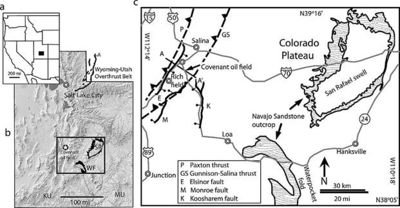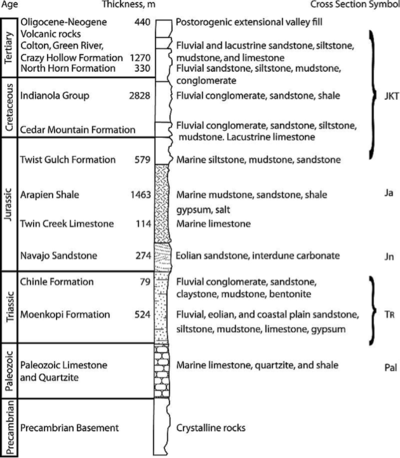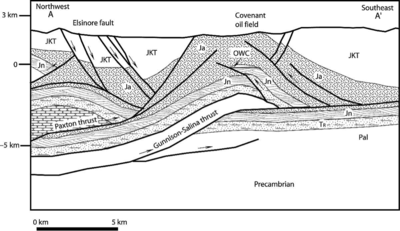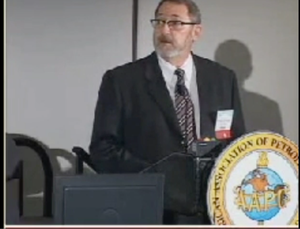Difference between revisions of "Covenant field"
Cwhitehurst (talk | contribs) (Created page with "The Covenant Field is an oil field located in Sevier County, Utah. The field was discovered in 2004 by Wolverine Oil and Gas, in the Kings Meadow Ranches #17-1 well when it...") |
Cwhitehurst (talk | contribs) |
||
| (27 intermediate revisions by the same user not shown) | |||
| Line 1: | Line 1: | ||
| − | + | [[File:CovenantFieldFig3.jpeg|thumb|400px|{{figure number|1}}a) Inset map of the western United States showing the location of Utah. (b) Shaded relief map of Utah showing the location of the [[overthrust]] belt of northeastern Utah and southwestern Wyoming and the Covenant oil field, including tectonic elements. SR = San Rafael swell; KU = Kaibab uplift; MU = Monument uplift; WF = Waterpocket fold; A = Absaroka thrust fault. (c) Covenant field locality map of central Utah. From Parry, et. al<ref name=Parry />]] | |
| − | [[ | + | The Covenant Field is an oil field located in Sevier County, Utah. The field was discovered in 2004 by Wolverine Oil and Gas, in the Kings Meadow Ranches #17-1 well when it encountered oil in the Navajo Formation. Credits for the geologic ideas behind the discovery have been attributed to Dr. [[Douglas K. Strickland]]. The work leading to this discovery is has been summarized by Strickland in several presentations at AAPG conferences.<ref name=Strickland05>Strickland, D., K. R. Johnson, J. P. Vrona, D. D. Schelling, and D. A. Wavrek, 2005, [http://www.searchanddiscovery.com/documents/2005/av/strickland/ndx_strickland.pdf Structural architecture, petroleum systems, and geological implications for the Covenant field discovery, Sevier County, Utah]: AAPG Search and Discovery Article No. 110014</ref><ref>Strickland, D., 2009, [http://player.piksel.com/player.php?v=bl432u69 Conventional Wisdom: A Different Approach Exploration in the Central Utah Thrust Belt]: Audio-Video presentations at 2009 AAPG Annual Convention, Denver, Colorado, June 7-10.</ref> |
| − | [[ | ||
==Structure== | ==Structure== | ||
| − | The Covenant field is located in the central Utah thrust belt. | + | [[File:CovenantFieldFig1.png|thumb|400px|{{figure number|2}}Generalized stratigraphic column of rock units the Covenant field area. The Lower Jurassic Navajo Sandstone is the reservoir, while the overlying Middle Jurassic Twin Peaks Limestone and Arapien Shale form the cap rocks or seal for the field. From Parry, et. al.<ref name=Parry />]] |
| + | [[File:CovenantFieldFig2.png|thumb|400px|{{figure number|3}}A NW-SE trending cross section showing the Covenant oil field structure, Paxton and Gunnison-Salina thrust, and normal faults bounding Sevier Valley. Note that OWC = oil-water contact for the covenant field. See Figure 2 for the key to the geologic symbols. From Parry, et. al.<ref name=Parry />]] | ||
| + | |||
| + | The Covenant field is located in the central Utah thrust belt. Chidsey, et al.<ref name=Chidsey>Chidsey, T. C., Jr., J. S. DeHamer, E. E. Hartwick, K. R. Johnson, D. D. Schelling, D. A. Sprinkel, D. K. Strickland, J. P. Vrona, & D. A. Wavrek, 2007, Central Utah: Diverse Geology of a Dynamic Landscape, Petroleum Geology of Covenant Oil Field, Central Utah Thrust Belt, pp. 273-296</ref> describe the Covenant field trap as an “elongate, symmetric, northeast-trending, fault-propagation/fault-bend anticline with nearly 800 feet (270m) of structural closure with a 450-foot (150M) oil column. The oil-charged Navajo reservoir covers about 960 acres.” The structure is related to movement along the Gunnison-Salina thrust and Paxton thrust fault and part of the larger Utah thrust belt province, this is outlined in greater detail by Chidsey et al.<ref name=Chidsey /> | ||
==Reservoir== | ==Reservoir== | ||
| − | The primary (as of 2007 | + | The primary (as of 2007) reservoir in the Covenant Field is the Navajo Sandstone Early Jurassic (Toarcian) eolian sandstone. Parry, Chan, and Nash<ref name=Parry>Parry, W. T., M. A. Chan, & B. P. Nash, 2009, [http://archives.datapages.com/data/bulletns/2009/08aug/BLTN08170/BLTN08170.HTM Diagenetic characteristics of the Jurassic Navajo Sandstone in the Covenant oil field, central Utah thrust belt]: AAPG Bulletin, vol. 93, no. 8, p. 1039-1061.</ref> outlined diagenetic charchteristics of the Navajo Sandstone from cores in the Covenant field. As of April 2015 the field had 24 active wells, and had produced a cumulative 21,443,660 barrels of oil.<ref>[https://oilgas.ogm.utah.gov/pub/Publications/Reports/Prod/Field/?C=M;O=D Field Production Reports, Utah]</ref> |
| + | |||
| + | {| class="wikitable" | ||
| + | |- | ||
| + | |+ {{table number|1}}Covenant Oil Field Reservoir Characteristics<ref name=Chidsey /> | ||
| + | |- | ||
| + | | colspan = 4 | Structural closure, 800 ft (270 m); oil column, 450 ft (150 m) | ||
| + | |- | ||
| + | | colspan = 4 | Reservoir depth, 6356 ft (1937 m) true vertical depth; subsea level depth, −94 ft (−29 m) | ||
| + | |- | ||
| + | | colspan = 4 | Oil-water contact, −603 ft (−184 m) | ||
| + | |- | ||
| + | | colspan = 4 | Reservoir temperature, 87°C (188°F); reservoir pressure, 2360 psi (18,134 kPa, 181 bar) | ||
| + | |- | ||
| + | | colspan = 4 | Average water saturation, 38% | ||
| + | |- | ||
| + | | colspan = 4 | 0.48% S, d13C = −29.4 to −29.0‰ | ||
| + | |- | ||
| + | | colspan = 4 | Structure: backthrust on the Gunnison-Salina thrust fault (Campanian to Paleocene) | ||
| + | |- | ||
| + | | colspan = 4 | Source rocks: [[Carboniferous]]; migration: Cretaceous to early Tertiary | ||
| + | |- | ||
| + | ! colspan = 4 center | Water Chemistry | ||
| + | |- | ||
| + | | Ca || 428 mg/l || HCO<sup>–</sup><sub>3</sub> || 518 | ||
| + | |- | ||
| + | | Mg || 41 || SO<sub>4</sub> || 3000 | ||
| + | |- | ||
| + | | Na || 10,080 || Cl || 14,100 | ||
| + | |- | ||
| + | | K || 220 || pH || 6.45 | ||
| + | |- | ||
| + | | Fe || 12 || Specific [[gravity]] || 1.0208 | ||
| + | |- | ||
| + | | SiO<sub>2</sub> || 46 || Total dissolved solids || 28,400 | ||
| + | |} | ||
==Significance== | ==Significance== | ||
| − | The significance of the Covenant discovery, summarized by Chidsey, is that it proved that the central Utah thrust belt contained the right components of trap, reservoir, seal, source and migration history for large accumulations of oil to occur. | + | The significance of the Covenant discovery, summarized by Chidsey,<ref name=Chidsey /> is that it proved that the central Utah thrust belt contained the right components of trap, reservoir, seal, source and migration history for large accumulations of oil to occur. In reflecting on the exploration work leading to its discovery Strickland noted that the Covenant field disproved many aspects of conventional wisdom as to the exploration potential of the region.<ref name=Strickland05 /> |
| − | + | [[File:StricklandCovSS.png|thumb|left|300px|Still of Strickland giving his talk on the discovery of the Covenant field in 2009. See full video [http://player.piksel.com/player.php?v=bl432u69 here]]] | |
| − | Strickland | + | {{clear}} |
| − | |||
| − | + | ==Related reading== | |
| − | + | * Brown, D., 2008, [http://www.aapg.org/publications/news/explorer/emphasis/articleid/11089/tricky-geology-is-utah-hallmark Tricky Geology Is Utah Hallmark]: AAPG Explorer | |
| − | + | * Hartwick, E. E., 2010, [http://www.searchanddiscovery.com/pdfz/documents/2010/20091hartwick/ndx_hartwick.pdf.html Eolian Architecture of Sandstone Reservoirs in the Covenant Field, Sevier County, Utah] | |
| − | + | * Strickland, D., 2009, [http://www.searchanddiscovery.com/documents/2009/110076strickland/ndx_strickland.pdf Conventional Wisdom: A Different Approach Exploration in the Central Utah Thrust Belt] | |
| − | |||
| − | |||
| − | |||
| − | |||
| − | |||
| − | + | ==References== | |
| − | + | {{reflist}} | |
| − | |||
| − | |||
| − | |||
| − | |||
| − | |||
| − | |||
| − | |||
| − | |||
| − | |||
| − | |||
| − | |||
| − | |||
| − | |||
| − | |||
Latest revision as of 19:39, 14 February 2017

The Covenant Field is an oil field located in Sevier County, Utah. The field was discovered in 2004 by Wolverine Oil and Gas, in the Kings Meadow Ranches #17-1 well when it encountered oil in the Navajo Formation. Credits for the geologic ideas behind the discovery have been attributed to Dr. Douglas K. Strickland. The work leading to this discovery is has been summarized by Strickland in several presentations at AAPG conferences.[2][3]
Structure[edit]


The Covenant field is located in the central Utah thrust belt. Chidsey, et al.[4] describe the Covenant field trap as an “elongate, symmetric, northeast-trending, fault-propagation/fault-bend anticline with nearly 800 feet (270m) of structural closure with a 450-foot (150M) oil column. The oil-charged Navajo reservoir covers about 960 acres.” The structure is related to movement along the Gunnison-Salina thrust and Paxton thrust fault and part of the larger Utah thrust belt province, this is outlined in greater detail by Chidsey et al.[4]
Reservoir[edit]
The primary (as of 2007) reservoir in the Covenant Field is the Navajo Sandstone Early Jurassic (Toarcian) eolian sandstone. Parry, Chan, and Nash[1] outlined diagenetic charchteristics of the Navajo Sandstone from cores in the Covenant field. As of April 2015 the field had 24 active wells, and had produced a cumulative 21,443,660 barrels of oil.[5]
| Structural closure, 800 ft (270 m); oil column, 450 ft (150 m) | |||
| Reservoir depth, 6356 ft (1937 m) true vertical depth; subsea level depth, −94 ft (−29 m) | |||
| Oil-water contact, −603 ft (−184 m) | |||
| Reservoir temperature, 87°C (188°F); reservoir pressure, 2360 psi (18,134 kPa, 181 bar) | |||
| Average water saturation, 38% | |||
| 0.48% S, d13C = −29.4 to −29.0‰ | |||
| Structure: backthrust on the Gunnison-Salina thrust fault (Campanian to Paleocene) | |||
| Source rocks: Carboniferous; migration: Cretaceous to early Tertiary | |||
| Water Chemistry | |||
|---|---|---|---|
| Ca | 428 mg/l | HCO–3 | 518 |
| Mg | 41 | SO4 | 3000 |
| Na | 10,080 | Cl | 14,100 |
| K | 220 | pH | 6.45 |
| Fe | 12 | Specific gravity | 1.0208 |
| SiO2 | 46 | Total dissolved solids | 28,400 |
Significance[edit]
The significance of the Covenant discovery, summarized by Chidsey,[4] is that it proved that the central Utah thrust belt contained the right components of trap, reservoir, seal, source and migration history for large accumulations of oil to occur. In reflecting on the exploration work leading to its discovery Strickland noted that the Covenant field disproved many aspects of conventional wisdom as to the exploration potential of the region.[2]

Related reading[edit]
- Brown, D., 2008, Tricky Geology Is Utah Hallmark: AAPG Explorer
- Hartwick, E. E., 2010, Eolian Architecture of Sandstone Reservoirs in the Covenant Field, Sevier County, Utah
- Strickland, D., 2009, Conventional Wisdom: A Different Approach Exploration in the Central Utah Thrust Belt
References[edit]
- ↑ 1.0 1.1 1.2 1.3 Parry, W. T., M. A. Chan, & B. P. Nash, 2009, Diagenetic characteristics of the Jurassic Navajo Sandstone in the Covenant oil field, central Utah thrust belt: AAPG Bulletin, vol. 93, no. 8, p. 1039-1061.
- ↑ 2.0 2.1 Strickland, D., K. R. Johnson, J. P. Vrona, D. D. Schelling, and D. A. Wavrek, 2005, Structural architecture, petroleum systems, and geological implications for the Covenant field discovery, Sevier County, Utah: AAPG Search and Discovery Article No. 110014
- ↑ Strickland, D., 2009, Conventional Wisdom: A Different Approach Exploration in the Central Utah Thrust Belt: Audio-Video presentations at 2009 AAPG Annual Convention, Denver, Colorado, June 7-10.
- ↑ 4.0 4.1 4.2 4.3 Chidsey, T. C., Jr., J. S. DeHamer, E. E. Hartwick, K. R. Johnson, D. D. Schelling, D. A. Sprinkel, D. K. Strickland, J. P. Vrona, & D. A. Wavrek, 2007, Central Utah: Diverse Geology of a Dynamic Landscape, Petroleum Geology of Covenant Oil Field, Central Utah Thrust Belt, pp. 273-296
- ↑ Field Production Reports, Utah